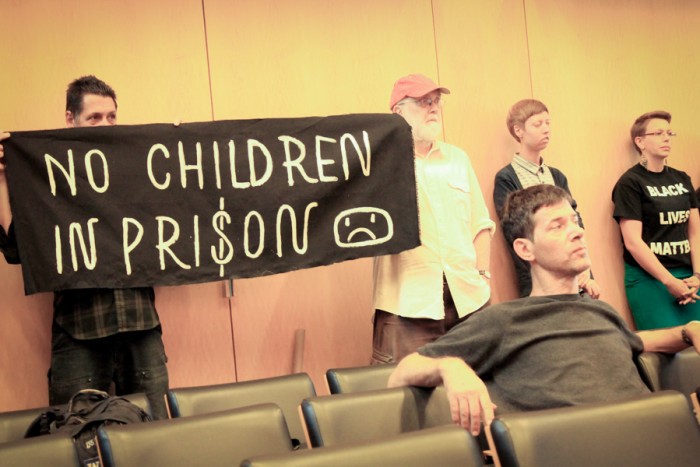
This story originally appeared in the South Seattle Emerald.
On Monday, the Seattle City Council and King County Superior Court piled the victories on local juvenile justice reformers.
The first came Monday afternoon when the city council authorized $600,000 to be dedicated to programs that provide alternatives to youth incarceration, including mentorship and preventative services.
Last September, at the urging of local youth incarceration reformers and abolitionists, the council passed a resolution to steer the city towards the goal of zero percent juvenile incarceration.
At the behest of these local organizers, the council also identified money in the city’s budget to begin developing solutions to divert youth from jails.
Today’s vote lifted a proviso held on the $600,000 and released the funds to the Social Justice Fund (SJF).
The nonprofit will work closely with the anti-racist organizing group Ending the Prison Industrial Complex (EPIC) to recruit 15-25 affected youth, community members, and parents to determine which community organizations will receive funds to identify incarceration alternatives.
“This project is really exciting to be developing with EPIC,” said Mijo Lee, Executive Director of the Social Justice Fund.
Of the $600,000 allocated by the city, the Social Justice Fund will receive $100,000 for running the giving program, with the remaining $500,000 distributed to community-led initiatives that address the root causes of incarceration.
While the SJF is technically the steward of the funds, the nonprofit has vowed to be deferential to its grassroots partner.
“We’re following EPIC’s lead. As they said, this isn’t a hand out, this is a community reclaiming this money,” affirmed Lee.
That the money was a direct result of community organizing was heavily underscored by those at the forefront of the reform movement.
“The Zero Youth Detention resolution and $600,000 that were set aside in the most recent city budget only happened because of the No New Youth Jail movement that has been building in Seattle for the past several years,” said James Williams, a South Seattle based community organizer with EPIC.
For the past several years, EPIC and other groups have spearheaded the No New Youth Jail movement against the construction of King County’s planned $210 million dollar Children and Family Justice Center, which will house a detention center, to be located in the city’s Central District and scheduled for completion in 2019.
On Monday, the county handed reformers additional good news, as King County Superior Court announced changes going into effect next month that it says could reduce juvenile detention books by as many as 250 youth per year.
Reductions, the county says, will have the greatest impact on youth of color, whose disproportionate imprisonment has been the crux of opponent’s arguments against the building, as it continues to grow despite a decline in overall numbers of incarcerated youth.
The court is doing that by making two significant changes to divert more youth away from detention and to continue a more than decade-long reduction in the use of juvenile detention:
- The first change comes with the addition of an on-call evening judge. When youth qualify for admission to detention but score below a certain level on a risk-assessment tool and have a responsible adult to whom they can be released, the information will be forwarded to a judge. If the judge agrees that release is appropriate, the youth will not be booked into detention and will go home – rather than spending one to three days in detention waiting to see a judge.
- The second change involves an expansion of Juvenile Court’s two-tier warrant system for youth who have been charged with crimes. For many years, judges have issued warrants for youth who fail to appear for court in two categories. Tier 1 warrants require a youth to be booked into detention and wait one to three days to see a judge. When police officers arrest youth with Tier 2 warrants, they call the court’s screening unit and get a new court date for the youth. This is communicated both to the youth and his or her guardian.
The court has decided to greatly expand the category of cases for which Tier 2 warrants can be issued. If this system had been in place in 2015, King County estimates that 250 admissions to detention could have been avoided. Superior Court estimates that this change will reduce the number of youth of color in detention, possibly reducing racial disproportionality.
The biggest change is that Tier 2 warrants will now be issued when youth miss their arraignments (the very first hearing) because, often, they have moved or are homeless and had no idea a hearing was scheduled. Considerations of both the type of crime and the type of hearing and whether there have been previous warrants all go into the decision about which type of warrant will be issued.
“It is exciting to be involved in a system that is committed to change, not just for the sake of change, but to achieve better outcomes for our youth and families,” said Chief Juvenile Court Judge Wesley Saint Clair. “It really does take a village to support our youth and families and I am proud that the court continues to devote itself to being a part of the change model.”
The proposal to expand the two-tier warrant system came from King County Public Defender Katherine Hurley, who supervises one of the juvenile units in the Department of Public Defense and who worked with her colleagues in DPD in crafting this proposal.
“The expansion of the two-tier warrant system is an important step towards reducing the unjust, unfair, and unacceptable disproportionality that exists in our juvenile justice system,” she said.
The celebration that the day’s news spurred in some was matched by sobering reflection in others.
“All of this will only work, if the movement continues to grow and the community keeps pressuring elected officials to do what’s right,” said Williams.
In other words, there’s much left to be done.

